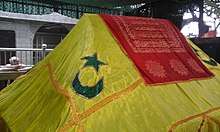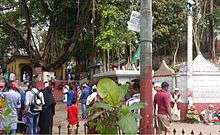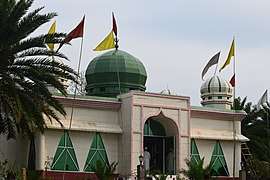Shah Paran
Shah Paran (Bengali: শাহ পরান, romanized: Shah Poran) was a 14th-century Sufi saint of the Sylhet region.[1] In 1303, he took part in the final battle of the Conquest of Sylhet led by his maternal uncle Shah Jalal.[2]
Shah Paran | |
|---|---|
শাহ পরান | |
 Tomb of Shah Paran | |
| Personal | |
| Born | Konya, Sultanate of Rum, (now in Turkey) or Hadhramaut, Yemen (disputed) |
| Died | |
| Religion | Islam |
| Parents |
|
| Denomination | Sufism |
| Muslim leader | |
| Based in | Sylhet |
| Period in office | 13th century to early 14th century |
| Predecessor | Shah Jalal |
| Post | Scholar and Sufi mystic |

Biography

Shah Paran's birth name is unknown though it is suggested that his name was Farhan which later became Poran, meaning "soul" and used as a term of endearment in the Bengali language. Others suggest that Shah Paran was a corruption of Shah Piran meaning "king of pirs".
He was born in Hadramaut, Yemen in the 13th century. His father's name was Muhammad who died when Paran was 11 years old. Paran studied under his grandfather Syed Ahmad Kabir Suhrawardi and later with Amin, a dervish from Neshapur. He decided to accompany Shah Jalal, his maternal uncle, in his expedition across the Indian subcontinent to propagate the religion of Islam.[3] In 1303, Paran took part in the final battle of the Conquest of Sylhet under Shah Jalal's leadership against Raja Gour Govinda. Following the victory, Shah Jalal ordered his companions to disperse across Eastern Bengal and surrounding areas. Paran established a khanqah on top of a hill in modern-day Khadim Nagar, Dakshingarh which came to be known as Shah Paran's hill.[4]
Death and legacy
Paran died unmarried and with no descendants. He was buried near his khanqah. A dargah complex was built with a neighbouring mosque, eidgah, langar khana, female prayer space and pond. For centuries, large numbers of devotees have visited his tomb, a practice which continues to the present time.[5] On the 4th, 5th and 6th day of Rabi-ul-Awal, the Urs of Shah Paran takes place.[6]
A bridge over the Surma River,[7] a passenger ferry,[8] and a residence hall at Shahjalal University of Science and Technology have all been named after Shah Paran.[9]
Spiritual genealogy
Spiritual genealogy of Shah Paran is as follows:[10]
- Muhammad
- Ali
- Hasan al-Basri
- Habib al-Ajami
- Maruf Karkhi
- Sari al-Saqati
- Khwaja Mumshad Uluw Al Dīnawarī
- Shaykh Ahmad Aswad Dinnuri
- Shaykh Abu Muhammad Amwiya
- Shaykh Azi Uddin Suhrawardi
- Shaykh Abu Nazib Ziauddin
- Shaykh Hisab Al-Din
- Shaykh Makhdum
- Bahauddin Zakariya
- Jalaluddin Surkh-Posh Bukhari
- Shaykh Ahmad Kabir Suhrawardi
- Shaykh Jalal
- Shah Paran
See also
References
- Kānunago, Sunīti Bhūshaṇa (1988). A History of Chittagong. Dipankar Qanungo. p. 476. OCLC 20170473.
- East Pakistan District Gazetteers: Sylhet. East Pakistan Government Press. 1970. p. 116.
- Administrator. "Hazrat Shah Paran". Londoni. Retrieved 3 July 2017.
- "Tomb of Hazrat Shah Paran (RA) - Offroad Bangladesh". Offroad Bangladesh. Retrieved 3 July 2017.
- McAdam, Marika (2004). Bangladesh. Lonely Planet. p. 148. ISBN 978-1-74059-280-2.
- "Urs at Shah Paran's shrine begins today". New Age. 13 March 2008. Archived from the original on 17 March 2008. Retrieved 7 October 2008.
- "Hazrat Shah Paran bridge to be opened in February". The New Nation. United News of Bangladesh. 25 December 2005. p. 2.
The Hazrat Shah Paran bridge, which is being constructed across the river Surma
- "Ferry with Eid passengers sinks". BBC News. 23 October 2006. Retrieved 7 October 2008.
- "JCD calls strike at Sust today". The Daily Star. 4 December 2004. Retrieved 7 October 2008.
- Systems, Cognitive (8 April 2012). "The seven golden chains of Shaykh Muhammad Siraj ad-Din Naqshbandi (d.1915)". Ghaffari. Retrieved 9 July 2017.